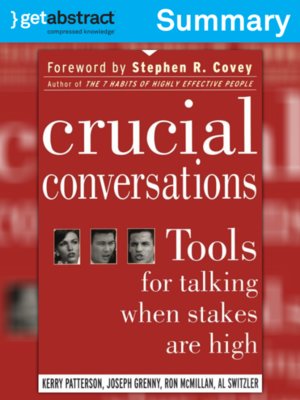

However, people do not have to make decisions at The end is precarious because people have to clarify Theīeginning is risky because people must be able to find a way toīegin safely. The end are the two riskiest times in crucial conversations. Part of their speech to show understanding. Respecting emotions that people show, and paraphrasing some There are some listening skills to retrace others’ pathsįrom action to its origin, like expressing interest in others’ views, The key for a successful crucial conversation is to use listening Indeed, if people want to keep themselves in a dialogue, Therefore, these signals can lead a person toīe aware that he or she is at risk of moving away from a healthyĭialogue.

They raise their voice, point their fingers like a weapon, or hit aĭesk with their hand. InĪddition, behavioral reactions can be the first cue for some people. Whatever they are, they can be signals of a crucial conversation. Some feel their stomach get tight or their eyes get dry, and some feel their palms get wet. Physical reactions are different from one person to another. These emotions can be cues for a person to slow down, step back, and take time to turn their brain back on. In emotional reactions, some people feel angry, hurt, or scared. They identify three main reactions in a crucial conversation: emotional, physical, and behavioral. The authors point out that in a conversation, there are some signs that indicate when a conversation can turn from a routine discussion into a crucial one. Success or failure in a crucial conversation can affect positively or negatively on communities, people’s relationships, and even people’s health. When two people or more discuss with different opinions, high stakes, and strong running of emotions, this conversation is a crucial conversation and may affect the quality of a person’s life. Therefore, controlling emotions is the key to preventing stressful conversations. Anger can make a person out of control, and a nervous person may say something without thinking and come to regret it later. In this case the emotional situation plays an important role in the conversation and makes it crucial. Then the husband becomes angry, and emotions run strong. For example, a couple is talking about their plan to have a baby, and suddenly the wife remembers the furniture. The stakes are high in this situation because the opinions are different between the couple, and that leads to an increase in the stress and tension between them. For example, a wife wants to buy new and expensive furniture, and her husband does not want to change their furniture. For example, when a couple is talking about choosing the neighborhoodįor their home, and they each have different opinions about that. Differentiation in opinions is one of the crucial conversation characteristics. There are three main characteristics of crucial conversations: opinion differentiation, high stakes, and emotions. Kerry Patterson, Joseph Grenny, Ron McMillan, and Al Switzler explain high stakes conversations and effective strategies in communication in their book.Ĭrucial conversations are daily conversations that affect our lives. This book is interesting for readers because it includes thoughts for successfulness in a crucial conversation and strategies to persuade others. Tools for Talking When Stakes Are High is a book that describes strategies for high stakes and important conversation. A successful crucial conversation requires effective communication skills that must be learned and developed. A crucial conversation is a dialogue under stress. Each person has his/her own strategies to persuade others, and these strategies may change according to the situation.

These ideas could be simple like buying a toy for a kid, or it could be complex like the legislation process in the senate. One of the purposes of conversations is to persuade others about ideas. There are many ways and strategies in communication and one of them is conversation. People need to communicate with each other to share ideas, thoughts, and opinions.


 0 kommentar(er)
0 kommentar(er)
